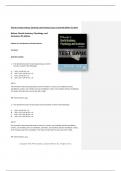Wheeler's Dental Anatomy, Physiology and Occlusion: Expert Consult 9th Edition Test Bank
Nelson: Dental Anatomy, Physiology, and
Occlusion, 9th Edition
Chapter 01: Introduction to Dental Anatomy
Test Bank
MULTIPLE CHOICE
1) The dental formula for the primary/deciduous teeth in
humans is which of the following?
A. I 2/2 C 1/1 M 2/2 = 10
B. I 2/2 C 1/1 P 1/1 M 2/2 = 12
C. I 2/2 C 2/2 M 2/2 = 12
D. I 2/2 C 1/1 P 1/1 M 1/1 = 10
ANS: A
The formula for the primary/deciduous teeth in humans is: Incisors, two maxillary and two
mandibular; canines, one maxillary and one mandibular; molars, two maxillary and two mandibular.
This makes 10 total teeth on each side, left or right.
REF: Nomenclature, pg. 2
2) The dental formula for the permanent human dentition is which of the following?
A. I 2/2 C 1/1 M 2/2 = 10
B. I 2/2 C 1/1 P 1/1 M 2/2 = 12
C. I 2/2 C 1/1 P 2/2 M 2/2 = 14
D. I 2/2 C 1/1 P 2/2 M 3/3 = 16
ANS: D
The formula for the permanent teeth in humans is: Incisors, two maxillary and two mandibular;
canines, one maxillary and one mandibular; premolars, two maxillary and two mandibular; molars,
three maxillary and three mandibular. This makes 16 total teeth on each side, left or right.
REF: Nomenclature, pg. 2
Copyright © 2010, 2003 by Saunders, an imprint of Elsevier Inc. All rights reserved.
,Wheeler's Dental Anatomy, Physiology and Occlusion: Expert Consult 9th Edition Test Bank
3) The notation for the primary maxillary left lateral incisor is which of the following according to
the Universal system?
A. D
B. G
C. E
D. F
ANS: B
According to the Universal system of notation, upper case letters are used for each of the primary
teeth. Maxillary teeth start with the right second molar and use letters A through J. The mandibular
teeth start with the left mandibular second molar and use letters K through T.
REF: Tooth Numbering Systems, pg. 3
4) The notation for the permanent mandibular right first premolar is which of the following
according to the Universal system?
A. 20
B. 21
C. 28
D. 29
ANS: C
According to the Universal system of notation, numbers 1 through 32 are used to designate the
permanent teeth. The system begins with the maxillary right third molar as 1 and continues to the
maxillary left third molar as 16. It continues with the mandibular left third molar as 17 and ends with
the mandibular right third molar as 32.
REF: Tooth Numbering Systems, pg. 4
5) The notation for the primary mandibular left canine is which of the following according to the FDI
system?
A. 53
B. 63
C. 73
D. 83
Copyright © 2010, 2003 by Saunders, an imprint of Elsevier Inc. All rights reserved.
,Wheeler's Dental Anatomy, Physiology and Occlusion: Expert Consult 9th Edition Test Bank
ANS: C
The FDI system utilized a two-number system of nomenclature. The following applies in the primary
dentition: for the first of the two digits, numeral 5 indicated the maxillary right, 6 the maxillary left, 7
the mandibular left, and 8 the mandibular right. The second digit represented the tooth number for
each side starting from the central incisors and continuing back.
REF: Tooth Numbering Systems, pg. 4
6) The notation for the permanent maxillary right first molar is which of the following according to
the FDI system?
A. 16
B. 26
C. 35
D. 45
ANS: A
The FDI system utilized a two-number system of nomenclature. The following applies in the
permanent dentition: for the first of the two digits, numeral 1 indicated the maxillary right, 2 the
maxillary left, 3 the mandibular left, and 4 the mandibular right. The second digit represented the
tooth number for each side starting from the central incisors and continuing back.
REF: Tooth Numbering Systems, pg. 4
7) Which of the following tissues found in teeth is responsible for furnishing blood and nerve supply
to the tooth?
A. Enamel
B. Cementum
C. Dentin
D. Pulp
ANS: D
Answers A, B, and C are known as “hard” tissues. Pulp is the only “soft” tissue that comprises tooth
structure. It is responsible for blood and nerve supply to the tooth.
REF: The Crown and Root, pg. 4
Copyright © 2010, 2003 by Saunders, an imprint of Elsevier Inc. All rights reserved.
, Wheeler's Dental Anatomy, Physiology and Occlusion: Expert Consult 9th Edition Test Bank
8) Which of the following represents the name of the bone of the tooth socket that firmly fixes each
tooth root?
A. Alveolar process
B. Alveolus
C. Cementoenamel junction
D. Dentinoenamel junction
ANS: B
The alveolar process is the portion of the jaw supporting the teeth. The cementoenamel junction and
dentinoenamel junction are both areas of the tooth itself where two different tissues join. The
alveolus specifically refers to the bone of the tooth socket.
REF: The Crown and Root, pg. 5
9) Which of the following terms represents the surface of a tooth that is facing toward an adjoining
tooth in the same dental arch?
A. Occlusal
B. Incisal
C. Facial
D. Proximal
ANS: D
The occlusal and incisal surfaces are those that come in contact with those in the opposite jaw during
the act of closure in the molar and premolars, and the incisors and canines, respectively. The facial
surface is the collective term used for tooth surfaces that face the cheeks and lips.
REF: Surfaces and Ridges, pg. 6
10) Which of the following pairs of teeth have mesial surfaces that touch each other (Universal
system)?
A. 7 and 8
B. 8 and 9
C. 22 and 23
D. 25 and 26
ANS: B
Copyright © 2010, 2003 by Saunders, an imprint of Elsevier Inc. All rights reserved.




